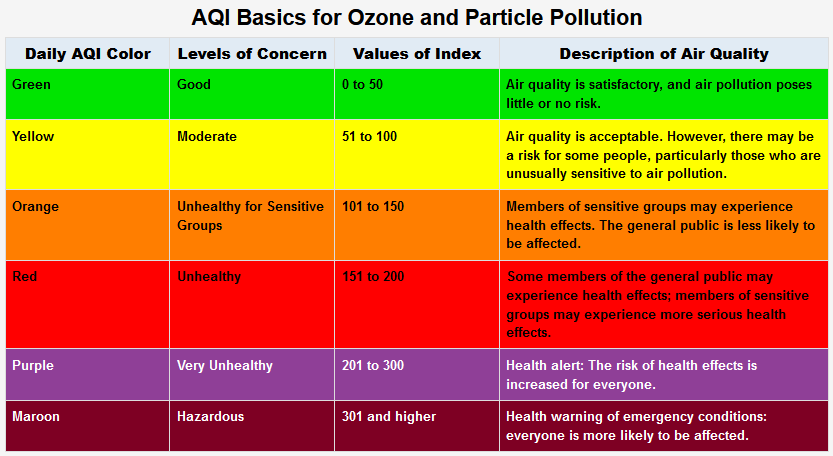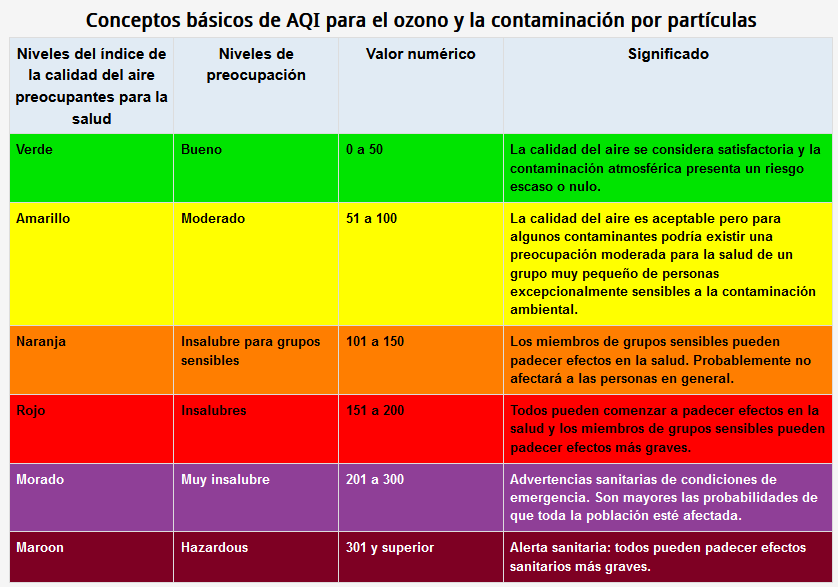Air Quality
Air Quality Information & Resources
Air quality refers to the condition of the air within our surroundings. It is assessed to determine how clean or polluted the air is and to understand its potential effects on health.
The Air Quality Index (AQI) is a key tool used to communicate the quality of the air. The AQI ranges from 0 to 500, with higher values indicating greater levels of pollution and associated health risks. The Environmental Protection Agency (EPA) has established an AQI for five major air pollutants regulated under the Clean Air Act: ground-level ozone, particulate matter, carbon monoxide, sulfur dioxide, and nitrogen dioxide.
AQI values of 100 or below are generally considered satisfactory. When AQI values exceed 100, air quality starts to become unhealthy, initially for sensitive groups, such as individuals with asthma, and progressively for the general population as the AQI values increase.
Air Pollution & Particulate Matter
Particulate matter (PM) consists of a mixture of solid particles and liquid droplets found in the air. These particles vary in size:
- PM10: Inhalable particles with diameters of 10 micrometers or smaller.
- PM2.5: Fine inhalable particles with diameters of 2.5 micrometers or smaller.
Particulate matter can come from direct emissions, such as those from a smokestack, or can form through chemical reactions in the atmosphere.
Particulate matter contains microscopic solids or liquid droplets that are small enough to be inhaled, leading to serious health issues. PM2.5, in particular, poses the greatest risk to health due to its ability to penetrate deep into the lungs and even enter the bloodstream.
Air Quality and Climate Change
Air pollution and climate change are both largely caused by the burning of fossil fuels and thus share the same solutions.
Climate change is expected to affect air quality. For instance, ground-level ozone, a harmful pollutant that can trigger chest pain, coughing, throat irritation, and congestion, will be worsened by climate change.
A changing climate is also expected to cause prolonged springs and summers, warmer temperatures, precipitation changes, and higher carbon dioxide concentrations. Collectively, these factors can increase individuals’ exposure to pollen and other airborne allergens, which in turn can lead to higher rates of allergy-related illnesses such as asthma.
Changes in the amount of outdoor air pollutants can also affect indoor air quality. Increases in outside air pollutants, such as ozone and particulate matter, could lead to higher indoor exposures, as pollutants can enter a building through open doors and windows, as well as ventilation systems. Indoor air quality can be improved by utilizing portable air purifiers with high-efficiency filters.
https://www.epa.gov/climateimpacts/climate-change-impacts-air-quality
Wildfires and Smoke
Wildfire smoke is a mixture of gases, water vapor, air pollutants and fine particulate matter. Climate change has already led to more frequent wildfires and a longer wildfire season. Wildfire smoke pollutes the air, impairing visibility and disrupting outdoor activities. It can also spread hundreds of miles downwind to other regions, as was seen in Connecticut in the summer of 2023 with the Canadian wildfire smoke.
Exposure to wildfire smoke can worsen respiratory illnesses like asthma, chronic obstructive pulmonary disease (COPD), and bronchitis.
Wildfires can be prevented by paying attention to weather and drought conditions, as well as avoiding activities involving fire and sparks when it’s dry, hot, and windy.
*Smoke and wildfire map https://fire.airnow.gov/
Air Quality Alerts
“State of the Air” is the American Lung Association’s annual national air quality “report card.” The 2025 State of the Air report states that 46% of Americans – 156.1 million people – are living in places that get failing grades for unhealthy levels of ozone or particulate pollution. This means nearly 25 million more people are breathing unhealthy air compared to last year.
Stay Informed: Use air quality alerts to stay aware of pollutant levels in your area.
- AirNow: Provides real-time air quality information.
- Purple Air: Offers detailed air quality data through a network of sensors.
By keeping yourself informed and taking precautionary measures, you can protect yourself and others from the harmful effects of particulate matter and other pollutants.
Something in the Air (2019) | Full Documentary
Resources

